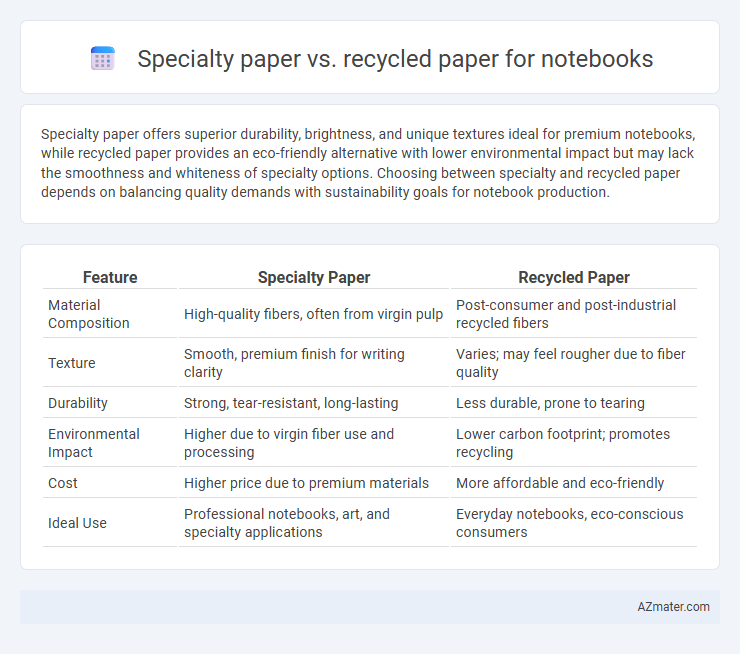Specialty paper offers superior durability, brightness, and unique textures ideal for premium notebooks, while recycled paper provides an eco-friendly alternative with lower environmental impact but may lack the smoothness and whiteness of specialty options. Choosing between specialty and recycled paper depends on balancing quality demands with sustainability goals for notebook production.
Table of Comparison
| Feature | Specialty Paper | Recycled Paper |
|---|---|---|
| Material Composition | High-quality fibers, often from virgin pulp | Post-consumer and post-industrial recycled fibers |
| Texture | Smooth, premium finish for writing clarity | Varies; may feel rougher due to fiber quality |
| Durability | Strong, tear-resistant, long-lasting | Less durable, prone to tearing |
| Environmental Impact | Higher due to virgin fiber use and processing | Lower carbon footprint; promotes recycling |
| Cost | Higher price due to premium materials | More affordable and eco-friendly |
| Ideal Use | Professional notebooks, art, and specialty applications | Everyday notebooks, eco-conscious consumers |
Introduction to Specialty and Recycled Paper
Specialty paper for notebooks features unique textures, colors, and finishes designed to enhance writing experience and aesthetics, often crafted from high-quality fibers like cotton or linen. Recycled paper is made from recovered fibers, emphasizing sustainability and environmental responsibility while maintaining functional durability for everyday notebook use. Both options serve distinct needs: specialty paper prioritizes premium feel and appearance, whereas recycled paper focuses on eco-friendly production and resource conservation.
Understanding Specialty Paper Types
Specialty paper for notebooks includes varieties such as coated, textured, and colored papers that enhance durability and aesthetic appeal, often used for premium notebook covers or pages. Recycled paper, made from post-consumer waste, emphasizes sustainability and environmental responsibility while offering a slightly different texture and often requiring additional processing for quality consistency. Understanding specialty paper types involves recognizing their distinct characteristics like weight, finish, and fiber content, which influence notebook usability, appearance, and ecological impact.
What Defines Recycled Paper?
Recycled paper is defined by its production from recovered paper materials, including post-consumer waste and industrial scraps, which reduces the demand for virgin wood fibers and minimizes environmental impact. Specialty paper for notebooks often includes recycled content, but its defining feature lies in tailored properties such as texture, weight, and brightness designed for specific uses. The quality and sustainability of recycled paper depend on the recycling process, fiber composition, and amount of post-consumer content, making it a key factor in eco-friendly stationary products.
Environmental Impact: Specialty vs Recycled Paper
Specialty paper for notebooks often involves higher resource consumption and chemical treatments, leading to increased environmental impact compared to recycled paper. Recycled paper significantly reduces deforestation, water use, and energy consumption by reprocessing post-consumer fibers. Choosing recycled paper supports waste reduction and lowers greenhouse gas emissions, making it a more sustainable option for eco-conscious consumers.
Performance and Durability Comparison
Specialty paper for notebooks offers superior performance with enhanced smoothness, brightness, and resistance to ink bleed-through, ensuring clear legibility and a premium writing experience. Recycled paper, while eco-friendly, typically has lower brightness and may exhibit reduced durability, such as increased susceptibility to tearing and faster wear from frequent use. Choosing specialty paper maximizes notebook longevity and writing quality, whereas recycled paper balances environmental benefits with moderate performance.
Writing Experience on Both Paper Types
Specialty paper offers a smoother, ink-absorbent surface that enhances pen glide and crisp, vibrant lines, making it ideal for detailed writing and artistic expression in notebooks. Recycled paper tends to have a slightly rougher texture and variable fiber composition, which can cause slight feathering or ink bleed, affecting the precision and clarity of handwriting. Writers seeking an optimal balance of eco-friendliness and quality often evaluate coated or high-grade recycled options to improve the overall tactile and visual experience.
Aesthetics and Customization Options
Specialty paper for notebooks offers superior aesthetics with a textured, high-quality finish that enhances color vibrancy and imprint clarity, ideal for premium branding and elegant designs. Recycled paper provides a unique, organic look with natural fibers and subtle imperfections, appealing to eco-conscious consumers seeking sustainable customization options. Both papers support diverse printing techniques, but specialty paper allows for finer detail and a wider palette of finishes, elevating notebook appearance and personalization possibilities.
Cost Differences and Market Availability
Specialty paper for notebooks typically incurs higher production costs due to premium materials and specific features like archival quality or unique textures, resulting in a higher retail price compared to recycled paper. Recycled paper, widely available in the market, is more cost-effective because it uses reclaimed fibers, reducing raw material expenses and environmental impact while maintaining adequate quality for everyday notebook use. Market availability favors recycled paper, offering diverse options across price points, whereas specialty paper is often limited to niche suppliers and premium segments.
Suitability for Artistic and Professional Use
Specialty paper offers superior texture, weight, and archival quality, making it ideal for artistic and professional notebooks requiring precise ink control, color vibrancy, and durability. Recycled paper often has a rougher texture and lower brightness, which may affect the visual quality and performance of artwork or professional presentations. For creators and professionals seeking premium results, specialty paper provides enhanced suitability compared to recycled alternatives.
Conclusion: Choosing the Right Paper for Your Notebook
Specialty paper offers unique textures and finishes that enhance the writing experience and visual appeal, making it ideal for personalized or high-end notebooks. Recycled paper provides an eco-friendly alternative that reduces environmental impact, often with comparable durability and print quality. Selecting the right paper depends on balancing desired aesthetics, sustainability goals, and budget considerations for your notebook project.

Infographic: Specialty paper vs Recycled paper for Notebook
 azmater.com
azmater.com